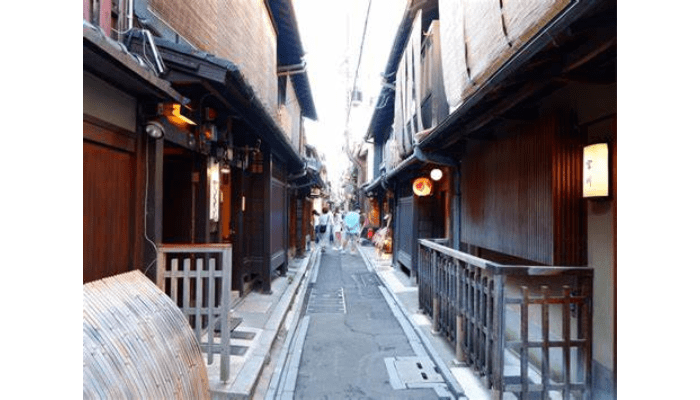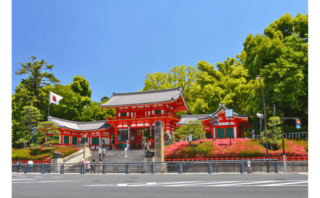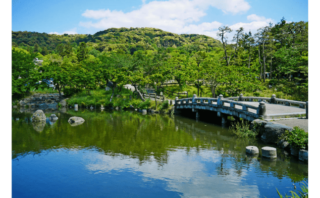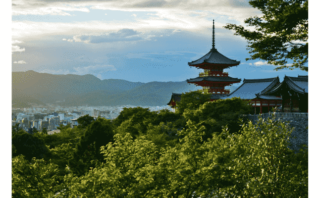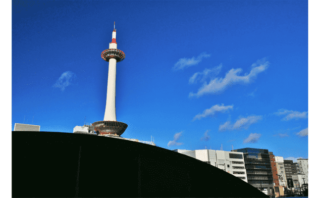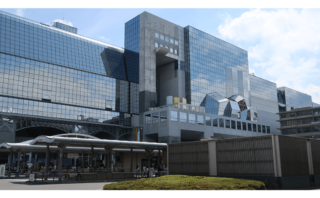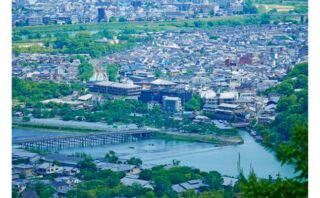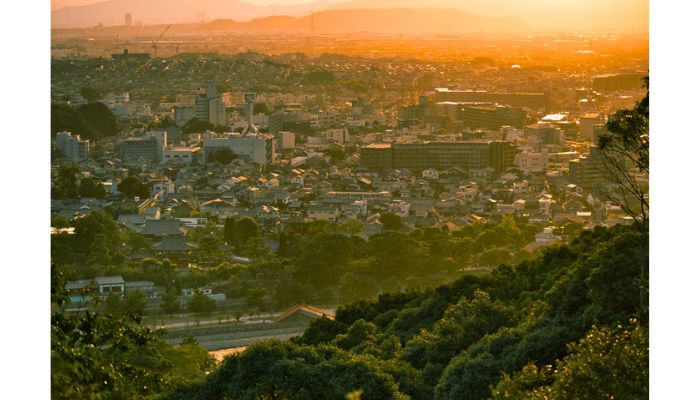Kawaramachi is one of Kyoto’s most vibrant shopping and entertainment districts. Known for its traditional Kyoto atmosphere, this area offers a variety of attractions that can be enjoyed throughout the seasons.
One of Kawaramachi’s highlights is its many shopping streets, including the famous Nishiki Market. In addition to sightseeing spots, the area is filled with restaurants, cafés, and souvenir shops, making it a great place to explore Kyoto’s food culture and shop for unique gifts.
With its rich Kyoto charm, Kawaramachi is the perfect area to take a leisurely stroll and soak in the city’s unique atmosphere. In this article, we’ll introduce a carefully selected list of must-visit attractions near Kawaramachi Station, including the nearby Gion district.
What Kind of Area is Kyoto’s Kawaramachi?
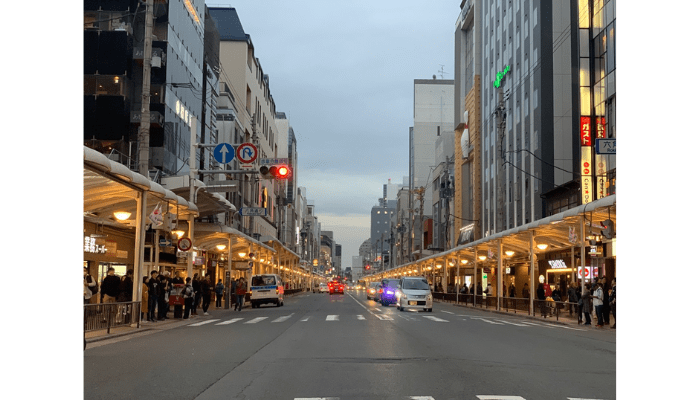
Kawaramachi is Kyoto’s largest shopping and entertainment district, located in the heart of the city. The name refers to the area around Kawaramachi Street, which runs north to south through Kyoto.
This lively area is often considered the best place to enjoy shopping and entertainment in Kyoto. Locals commonly refer to it as “Kawaramachi” or “Shijo,” while younger people sometimes call it “Machi.” It attracts not only tourists but also locals of all ages, including students, business professionals, and seniors.
Kawaramachi is home to some of Kyoto’s most famous department stores, such as Takashimaya Kyoto, known for its top sales in the city, Daimaru Kyoto, a long-established store, and Fujii Daimaru, which caters to younger shoppers. The area is filled with restaurants, cafés, and various shopping facilities, making it a great place for both shopping and dining. Whether you’re looking for lunch, dinner, or just a place to take a break during sightseeing, you’ll find plenty of options.
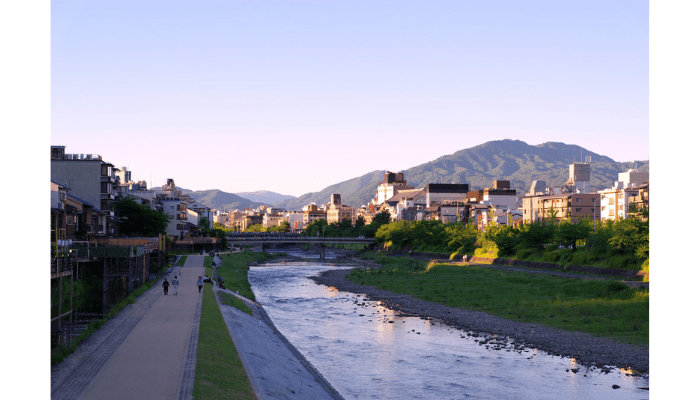
The main attractions in Kawaramachi are divided by the Kamo River, with Kawaramachi on one side and Gion on the other. Everything is within walking distance, allowing you to enjoy Kyoto’s unique atmosphere while exploring the area, dining, and shopping.
Kawaramachi is also a convenient base for sightseeing, with many hotels and guesthouses in the area. Staying here makes it easy to explore Kyoto’s famous attractions while enjoying the vibrant city life.
How to Get to Kawaramachi
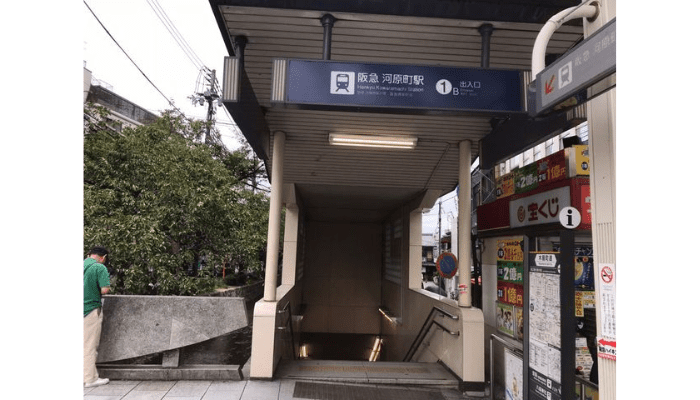
To reach Kawaramachi, start by heading to JR Kyoto Station. From there, you have three main options: bus, train, or taxi.
By Bus
Take a city bus from Bus Stop A2 in front of JR Kyoto Station. You can ride bus No. 4, 17, or 205 and get off at Shijo Kawaramachi.
- Travel time: About 15 minutes
- Fare: ¥230 one way
- If you plan to take the bus three or more times in a day, it’s best to buy a 1-day bus pass for ¥600.
Buses are the cheapest option, making them ideal for budget-conscious travelers.
By Train
Take the JR Nara Line from Kyoto Station and transfer to the Keihan Line at Tofukuji Station.
- Trains run about every 10 minutes, but they are less frequent than Hankyu or subway trains.
- Travel time: About 15 minutes
- Fare: ¥270
By Taxi
A taxi from JR Kyoto Station to Kawaramachi takes about 10 minutes, depending on traffic.
- Fare: Around ¥1,010 – ¥1,200
- Fastest option, but the most expensive
- Keep in mind that traffic congestion during peak hours may increase both travel time and fare.
Choose the option that best suits your budget and schedule!
Classic Things to Do in Kawaramachi
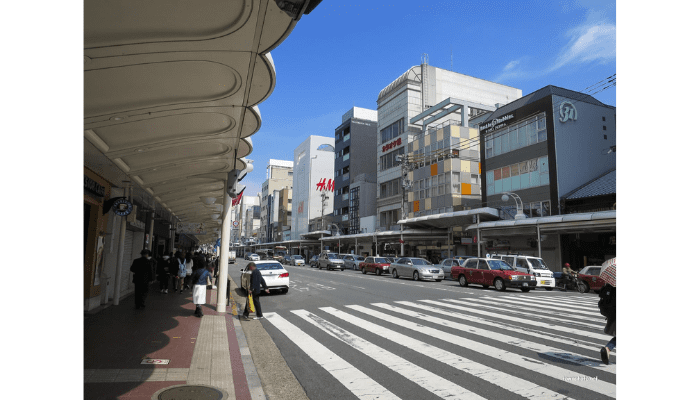
Kawaramachi is located on the west side of the Kamo River. During spring, the area is home to beautiful cherry blossom spots, including Gion Shirakawa, making it a perfect place for seasonal sightseeing.
1. Takase River
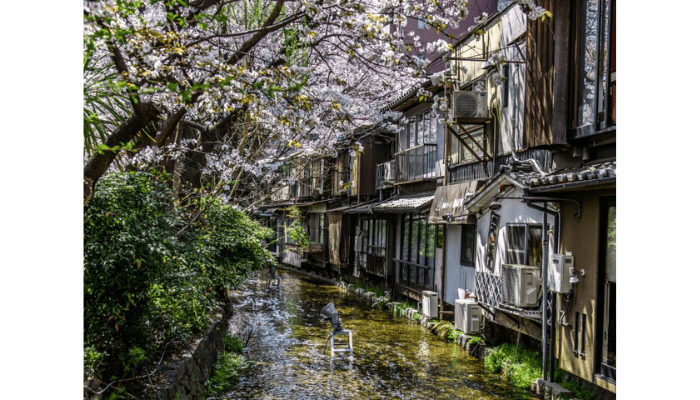
The Takase River is a small canal located right in front of Kawaramachi Station. It runs parallel to the Kamo River on the western side, flowing north to south.
During the Edo period (1603–1868), the river was used for transporting goods between Kyoto and Osaka via small wooden boats called Takasebune. It was also the setting of Mori Ogai’s famous novel Takasebune.
Today, the area along the Takase River, from Nijo to Gojo, is lined with restaurants and bars along Kiyamachi Street, making it one of Kyoto’s most popular nightlife districts. However, it is also known as a cherry blossom viewing spot, making spring the best season to visit.
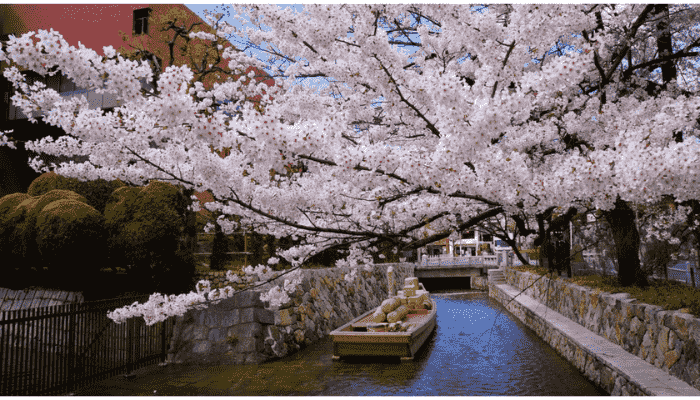
In spring, around 200 Somei Yoshino cherry trees bloom along the 1 km stretch between Shijo and Gojo. The beautiful cherry blossom tunnel creates a relaxing atmosphere, perfect for a leisurely riverside stroll. You can also enjoy dining at restaurants while admiring the cherry blossoms.
Along the Takase River, you’ll also find historical stone monuments related to events from the late Edo period, offering a glimpse into Kyoto’s past. Despite being in the bustling entertainment district, this area provides a quiet and peaceful escape.
Takase River
- Location: Near Kiyamachi Street, Nakagyo Ward, Kyoto
- Google Maps: Click here
- Access:
- Right in front of Kyoto Kawaramachi Station
- A short walk from Keihan Shijo Station or Keihan Gojo Station
2. Nishiki Market
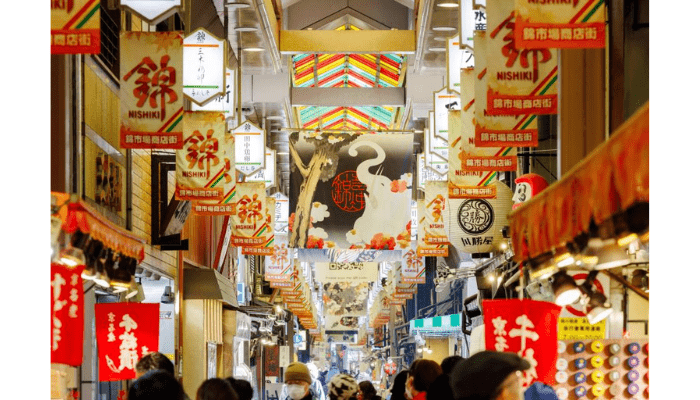
Nishiki Market is a 390-meter-long shopping street with a history of over 400 years. Known as “Kyoto’s Kitchen,” it is home to around 130 shops selling fresh ingredients, traditional snacks, and unique souvenirs.
Here, you’ll find a mix of long-established shops, trendy souvenir stores, and casual izakaya (Japanese pubs) where you can stop for a quick drink.
Must-Try Local Specialties
- Hiro Special Croquette (弘特製コロッケ) – Sold at Kyoto Meat Shop Hiro Nishiki (京のお肉処 弘 錦), this croquette is famous for its crispy outside and juicy, flavorful filling. The shop also serves steak and wagyu sushi.
- Kyoto Nama-Fu Dengaku (京生麩の田楽) – A Kyoto-style grilled wheat gluten skewer, available at Fufusa Roho (麩房老舗), a shop that has been in business since the Tenpo era (1830s). Only 100 servings are available daily, so be sure to visit early!
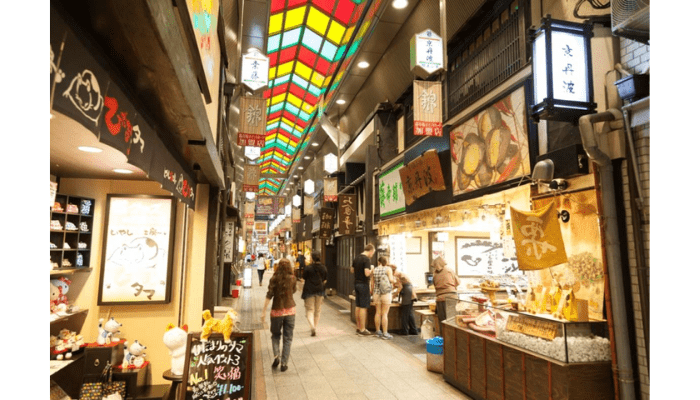
Why Visit Nishiki Market?
- Covered Shopping Street: Since the market has a roof, you can explore comfortably even on rainy days.
- Perfect for Foodies: Enjoy a leisurely food walk—set aside 1 to 2 hours to fully experience it.
- More Than Just Street Food: You can also buy Kyoto sweets, souvenirs, and ready-made side dishes for dinner.
- Near Nishiki Tenmangu Shrine: The market entrance is located right in front of Nishiki Tenmangu Shrine. Before diving into your food adventure, take a moment to offer a prayer at this historic shrine.
Nishiki Market
- Address: 609 Nishidaimonjicho, Nakagyo Ward, Kyoto, Japan
- Google Maps: Click here
- Access:
- Subway: 3 min walk from Shijo Station (Karasuma Line)
- Train:
- 3 min walk from Karasuma Station (Hankyu Kyoto Line)
- 4 min walk from Kyoto-Kawaramachi Station (Hankyu Kyoto Line)
- 10 min walk from Shijo Station (Keihan Main Line)
- Bus: 2 min walk from the Shijo-Takakura (Daimaru Department Store) bus stop (Kyoto City Bus No. 5)
- Hours: Varies by store
- Closed: Varies by store
- Official Website: Nishiki Market
3. Nishiki Tenmangu Shrine
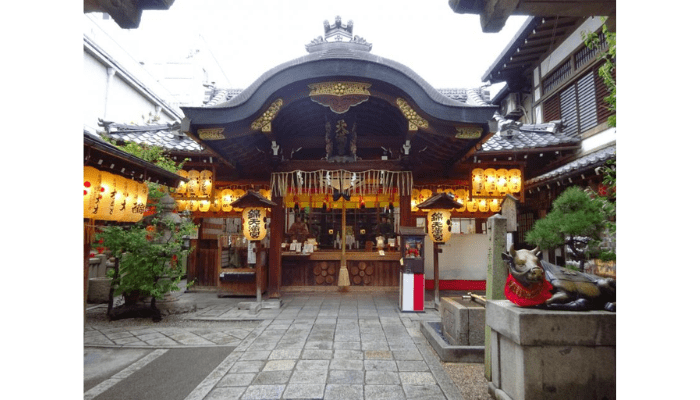
Nishiki Tenmangu Shrine is a small Shinto shrine located along Shinkyogoku Street in central Kyoto. It was originally built on the birthplace of Sugawara no Michizane, the deity of learning, during the Heian period (794–1185). Later, during the Azuchi-Momoyama period (16th century), it was moved to its current location as part of Toyotomi Hideyoshi’s city planning.
Because Michizane is enshrined here, students and businesspeople often visit to pray for academic success, business prosperity, good fortune, and protection from misfortune.
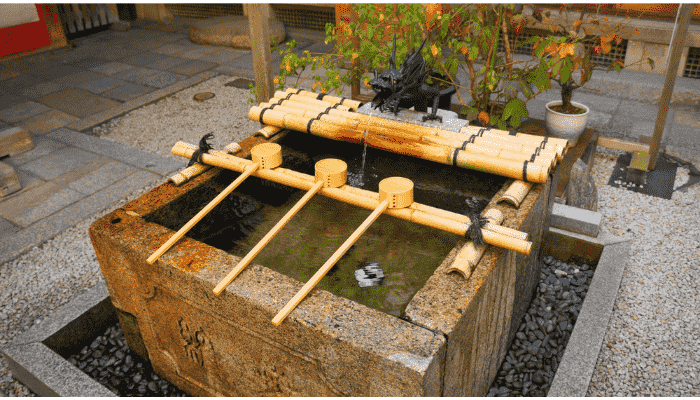
Highlights of Nishiki Tenmangu Shrine
- Nishiki-no-Mizu (錦の水) – One of Kyoto’s famous natural spring waters, flowing from a well inside the shrine.
- Taigan Ume (大願梅) – A sacred plum tree, believed to grant wishes. It is located toward the back left of the shrine grounds.
- Goshin-gyu (御神牛) – A “nade ushi” (rubbing ox) statue, similar to the one at Dazaifu Tenmangu Shrine in Fukuoka. Touching the ox is said to bring good luck and health.
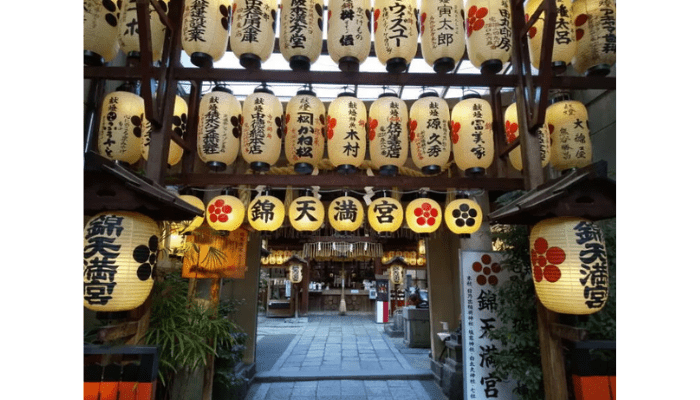
Though the shrine is small, it is packed with interesting features. Due to its location near the shopping district, it is often crowded, but mornings are quieter. If you want to explore at a relaxed pace, visiting early in the morning is recommended.
Nishiki Tenmangu Shrine
- Address: 537 Nakanocho, Nakagyo Ward, Kyoto, Japan
- Google Maps: Click here
- Access:
- Train: 5 min walk from Kyoto-Kawaramachi Station (Hankyu Line)
- Bus: 5 min walk from Shijo-Kawaramachi Bus Stop
- Phone Number: +81-75-231-5732
- Hours: 8:00 AM – 8:00 PM
- Admission: Free
- Closed: Open daily
- Official Website: Nishiki Tenmangu Shrine
4. Pontocho
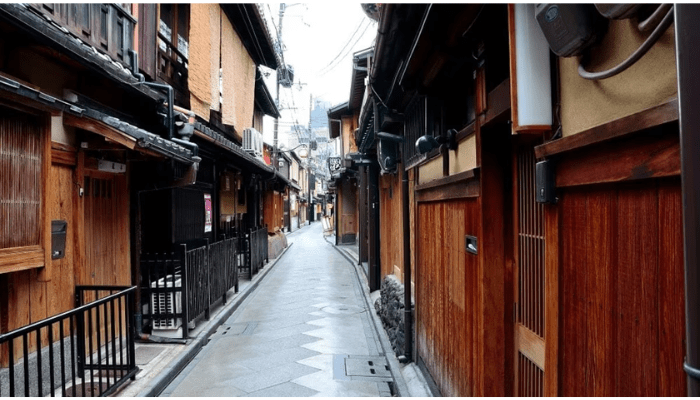
Pontocho is a narrow, atmospheric alley stretching 500 meters along the Kamo River, near Shijo-Kawaramachi Station. It is one of the best places in Kyoto to experience a traditional Kyoto-style atmosphere.
Pontocho is also one of Kyoto’s five “kagai” (geisha districts), where geiko (geisha) and maiko (apprentice geisha) train in traditional singing, dancing, and performing arts. The area is home to izakayas, upscale kaiseki restaurants, and local hidden gems, as well as ochaya (teahouses) where geiko and maiko entertain guests.
One of Pontocho’s main attractions is the Pontocho Kaburenjo Theater, where seasonal geisha performances are held. In recent years, more modern, stylish restaurants have opened, attracting a younger crowd while still preserving the area’s historic charm.
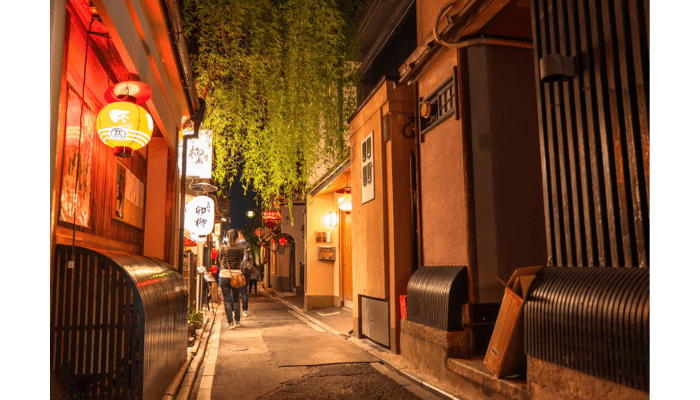
Walking through Pontocho, you’ll feel as if you’ve stepped back in time. The alley is lined with traditional wooden buildings, and as evening falls, the soft glow of “Chidori” lanterns creates a magical atmosphere.
The charming alleyway is perfect for photography, so be sure to bring your camera and capture Kyoto’s timeless beauty.
While simply exploring the alley is a great experience, there are also many welcoming teahouses, dessert cafés, and izakayas where even first-time visitors can feel comfortable. If a shop catches your eye, don’t hesitate to step inside and enjoy Kyoto’s local flavors.
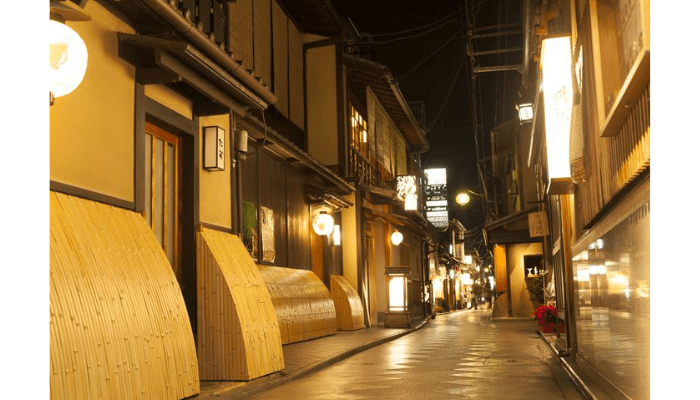
How Long to Explore Pontocho?
- Walking the entire alley takes about 10 minutes, but if you explore at a relaxed pace, 30 minutes or more is ideal.
- Pontocho is also conveniently located near Kawaramachi Station and other famous sightseeing spots, making it an easy stop on your Kyoto itinerary.
For a deep Kyoto experience, take a leisurely walk through Pontocho and immerse yourself in its traditional charm!
Pontocho
- Address: Around Nakagyo Ward, Kyoto, Japan
- Google Maps: Click here
- Access:
- Keihan Sanjo Station: 5 min walk
- Kyoto City Hall Station: 10 min walk
- Keihan Gion-Shijo Station: 3 min walk
- Hankyu Kawaramachi Station: 5 min walk
- Hours: Varies by shop
- Closed: Varies by shop
- Official Website: Pontocho
Classic Things to Do in Gion
Gion is located on the right side of the Kamo River when looking at a map.
This famous district is not only home to many popular sightseeing spots, but also offers a variety of ways to enjoy your visit. You can explore traditional streets, try local snacks while strolling through shopping arcades, and dine at a wide range of restaurants.
Whether you’re interested in history, culture, or food, Gion has something for everyone!
1. Gion Shirakawa

Gion Shirakawa is a picturesque street lined with traditional townhouses (machiya) featuring red lattice windows and stone-paved paths. It’s a spot that often appears in Japanese TV dramas, and for many, it’s the image that comes to mind when they think of Kyoto.
If you’re lucky, you might even catch a glimpse of a geiko or maiko gracefully walking by.

In spring, the area becomes even more stunning with cherry blossoms blooming along the Shirakawa River, surrounded by elegant traditional restaurants and houses. There are around 40 cherry trees, including Somei Yoshino and weeping cherry trees, creating a breathtaking view that attracts many visitors.
I visited during the peak cherry blossom season, and the trees were in full bloom, painting the area with soft pink hues. At night, the blossoms are illuminated, offering a magical view of yozakura (nighttime cherry blossoms)—an experience you shouldn’t miss.
Even in the morning, the area is lively with women in kimono and couples taking wedding photos against the beautiful backdrop.

Crossing the small bridges and walking through the narrow alleys, you’ll find yourself surrounded by historic buildings, giving you a true sense of Kyoto’s charm. It’s the perfect place to take a leisurely stroll and soak in the traditional atmosphere.
While spring is famous for cherry blossoms, Gion Shirakawa offers stunning scenery year-round:
- Summer: Fresh green leaves
- Autumn: Vibrant fall foliage
- Winter: A peaceful snow-covered landscape
You’ll find yourself stopping often to capture beautiful photos.
Gion Shirakawa
- Address: Along Shirakawa Minami-dori, Motoyoshi-cho, Higashiyama Ward, Kyoto
- Map: [Google Maps]
- Access: About a 3-minute walk from Gion-Shijo Station (Keihan Main Line) or a 7-minute walk from the Gion bus stop
- Official Website: Gion Shirakawa
2. Shijo Ohashi
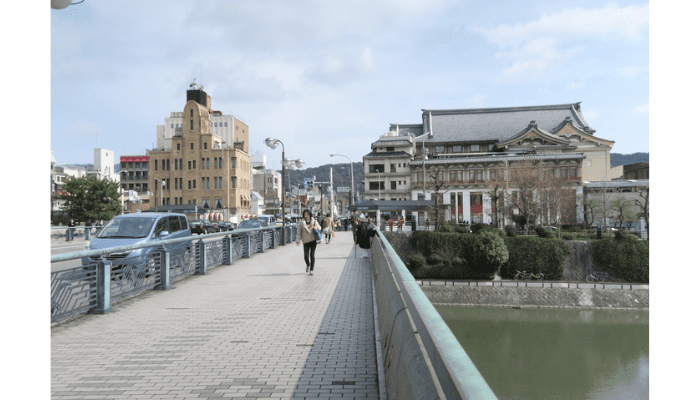
Shijo Ohashi is a large bridge that spans the Kamo River along Shijo Street.
If you walk east from Shijo Kawaramachi Station along Shijo Street, you’ll soon reach this iconic bridge. The Kamo River is part of the Yodo River system, which flows all the way to Osaka, passing under famous landmarks like Sanjo Ohashi and Shijo Ohashi along the way.
Interestingly, Shijo Ohashi serves as a natural divider between Kawaramachi (to the west) and Gion (to the east), making it a helpful landmark when navigating the area.
Right next to the bridge, you’ll find Toka Saikan, a historic Peking cuisine restaurant built in 1926. This building is registered as a Tangible Cultural Property of Japan and features a charming retro Taisho-era design that’s easy to spot from the outside.
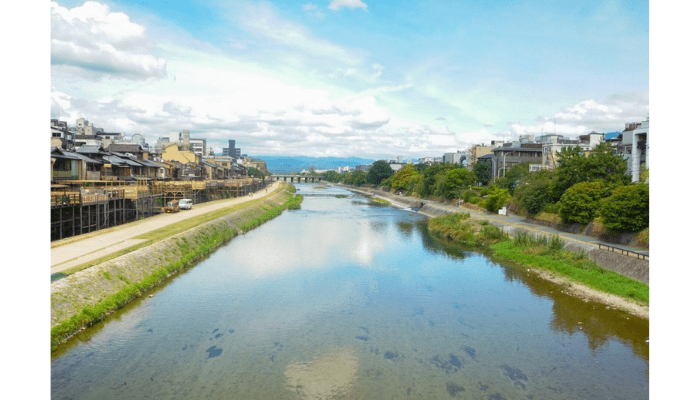
The view from the bridge is fantastic, offering a panoramic scene of the Kamo River, especially beautiful during sunrise or sunset. It’s a great place to snap some memorable photos of Kyoto’s cityscape blended with nature.
The Kamo River is also famous for the sight of couples sitting evenly spaced along its banks—a unique and charming scene in Kyoto.
If you have time, consider heading down beneath the bridge to sit by the riverside. Watching the gentle flow of the river while relaxing on the steps can be surprisingly soothing, offering a peaceful break from the bustling city.
Shijo Ohashi
- Address: Located between Kashiwaya-cho (Nakagyo Ward), Kawabata-cho (Higashiyama Ward), and Saito-cho (Shimogyo Ward), Kyoto
- Map: [Google Maps]
- Access: Just steps from Gion-Shijo Station (Keihan Main Line) and Kawaramachi Station (Hankyu Kyoto Line)
- Official Website: Shijo Ohashi
3. Yasaka Shrine
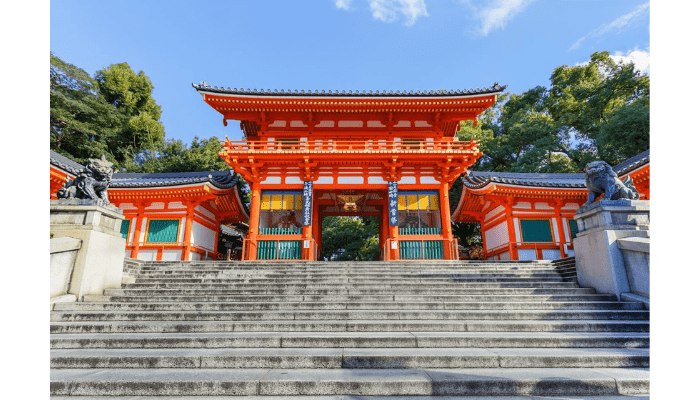
Yasaka Shrine is the head shrine of over 2,300 Yasaka Shrines across Japan, dedicated to the deity Susanoo-no-Mikoto, along with other important deities. It’s affectionately known as “Gion-san” by locals and is a popular power spot for beauty and love in Kyoto.
This famous shrine attracts countless visitors from all over Japan, especially during festivals and special events.

The shrine’s main hall, built in the unique “Gion-zukuri” style, is designated as an Important Cultural Property of Japan. This architectural style is distinctive because the main sanctuary (honden) and the worship hall (haiden) are covered under one large roof, a rare feature not commonly seen in other shrines.
The current main hall was rebuilt in 1654 under the order of Tokugawa Ietsuna, the 4th shogun of the Tokugawa dynasty.
Inside the main hall, three deities are enshrined:
- Susanoo-no-Mikoto (god of sea and storms)
- Kushiinadahime-no-Mikoto (goddess of beauty and harvest)
- Yahashira-no-Miko-kami (eight offspring deities of Susanoo)
Besides the main hall, there are many other sacred spots to explore within the shrine grounds, including:
- Dance Stage (Buden)
- Hiyoshi Shrine
- Hamono Shrine (dedicated to blades)
- Soreisha (ancestral shrine)
- Itsukushima Shrine

At times, you’ll find food stalls set up within the shrine grounds, where you can enjoy light snacks while exploring.
Yasaka Shrine is located within walking distance from Kawaramachi and is close to other popular Kyoto attractions such as:
Yasaka Shrine (Kyoto)
- Address: 625 Gionmachi Kitagawa, Higashiyama Ward, Kyoto
- Map: [Google Maps]
- Access: 5-minute walk from Gion-Shijo Station (Keihan Line)
- Phone: +81-75-561-6155
- Open: No holidays, open for visits 24 hours a day
- Office Hours: 9:00 AM – 5:00 PM
- Official Website: Yasaka Shrine
4. Maruyama Park

Maruyama Park is the oldest park in Kyoto, established in 1886. Spanning an impressive 8,600 square meters, it was designated as a Place of Scenic Beauty by the Japanese government in 1931.
Located right next to Yasaka Shrine and Chion-in Temple, the park is a beloved spot for both locals and tourists, offering beautiful views that change with each season.
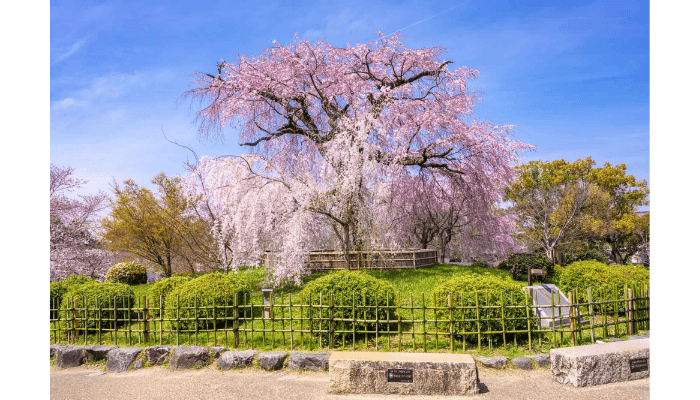
Seasonal Highlights of Maruyama Park
- Cherry Blossoms (Late March to Early April):
Maruyama Park is one of Kyoto’s top cherry blossom spots, especially famous for the stunning “Gion Weeping Cherry Tree” (Shidare-zakura). During cherry blossom season, the park is lively with visitors enjoying hanami (flower viewing).
At night, the cherry trees are illuminated, creating a magical atmosphere perfect for evening strolls. - Fresh Greenery (Early Summer):
In early summer, the park is filled with vibrant green leaves, offering a refreshing escape. While spring and autumn can be crowded, summer is quieter—ideal for a peaceful visit. - Autumn Leaves (November):
In autumn, the park’s Japanese maple trees (Iroha-momiji) turn brilliant shades of red and orange, making it a breathtaking spot for fall foliage.
The Hyotan Pond reflects the colorful leaves on clear days, creating postcard-worthy scenery.

Maruyama Park is spacious, with plenty of benches and small shops where you can grab a snack. It’s not just a sightseeing spot—it’s also great for a picnic with family or friends.
Whether you visit in spring, summer, autumn, or winter, Maruyama Park always offers something beautiful to see.
Maruyama Park (Kyoto)
- Address: Maruyama-cho, Higashiyama Ward, Kyoto
- Map: [Google Maps]
- Access:
- 12-minute walk from Gion-Shijo Station (Keihan Line)
- 13-minute walk from Kawaramachi Station (Hankyu Line)
- 15-minute walk from Sanjo Keihan Station (Kyoto Subway)
- Phone: +81-75-561-1350 (Kyoto City Greenery Association)
- Open: 24 hours (Cherry blossom lights: sunset to 10 PM in spring)
- Admission: Free
- Official Website: Maruyama Park
Kawaramachi is a bustling district where you can enjoy everything from sightseeing and shopping to dining.
With convenient train and bus connections, it’s easy to reach other popular tourist spots from here, making it a great base for exploring Kyoto.
Staying in Kawaramachi is also highly recommended if you want to be in the heart of the city.
Come and experience the charm of Kyoto in Kawaramachi!
▼ Related Articles for Kyoto Sightseeing
